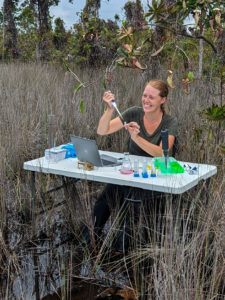Postdoctoral Research Associate
Genetic underpinnings of trap function and development in Nepenthes
I am a biochemist with a PhD in Molecular Plant Sciences from Washington State University, USA. As a postdoctoral researcher in the Mechanical Ecology Lab, I am investigating the developmental patterning of the slippery trap rim surface as well as the regulation of ‘stickiness’ in the trapping fluids of Nepenthes.
The pitcher rim turns into a deadly water slide for insects when wet. Water spreads rapidly on the rim and forms a thin lubricating film that causes insects to ‘aquaplane’ like a car tyre on a wet road. The extraordinary wettability and water spreading behaviour are based on a complex surface pattern of ridges and grooves on two different length scales. Cryo-scanning electron microscopy in our lab recently revealed that this complex microtopography develops via a series of distinct stages and patterning events. Together with Oona Lessware, I use transcriptome analysis to gain an insight into the regulation of surface patterning during trap development.
Nepenthes rafflesiana (and some other species of Nepenthes) contain viscoelastic trapping fluids which help to retain insects which have fallen into the pitcher. Preliminary chemical characterization suggests that these fluid properties are based on a complex branched polysaccharide in the pitcher fluid. Through field work with natural populations of N. rafflesiana in Brunei, former lab member Nathaniel Kelly and I showed that viscoelasticity decreases as the digestive enzyme activity increases over the lifespan of a pitcher. This suggests that there is a functional shift from a trapping- to a digestion-optimised fluid. My current research aims to investigate the underlying chemical and genetic mechanisms of these changes.
